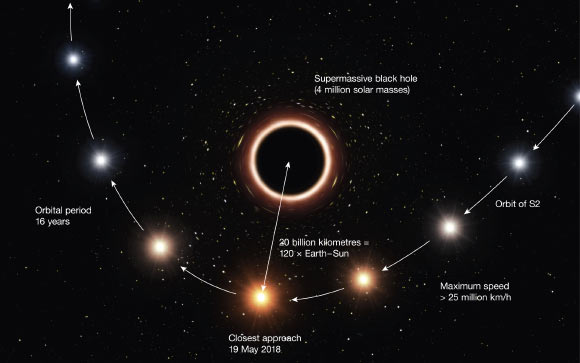Physicists Propose New Method to Detect Traversable Wormholes | Astronomy, Physics – Sci-News.com
In a new paper published this month in the journal Physical Review D, a duo of theoretical physicists from Case Western Reserve University, the University at Buffalo College of Arts and Sciences and Yangzhou University described a technique for detecting traversable wormholes — theoretical portals through space-time that could create shortcuts for long journeys across the Universe. The team’s method focuses on spotting a wormhole around Sagittarius A*, a supermassive black hole in the center of our Milky Way Galaxy.

Wormholes are predicted by the theory of general relativity. Digital art by Les Bossinas, Cortez III Service Corp., 1998.
“If wormholes are ever discovered, they’re not going to be the kind that science fiction often envisions,” said Professor Dejan Stojkovic, a cosmologist at the University at Buffalo College of Arts and Sciences.
“Even if a wormhole is traversable, people and spaceships most likely aren’t going to be passing through. Realistically, you would need a source of negative energy to keep the wormhole open, and we don’t know how to do that. To create a huge wormhole that’s stable, you need some magic.”
Nevertheless, wormholes — traversable or not — are an interesting theoretical phenomenon to study.
While there is no experimental evidence that these passageways exist, they are possible — according to theory.
“They are a legitimate solution to Einstein’s equations,” Professor Stojkovic noted.
The paper by Professor Stojkovic and his colleague, Dr. De-Chang Dai of Yangzhou University and Case Western Reserve University, focuses on how astronomers could hunt for a wormhole by looking for perturbations in the path of S2, a star in orbit around Sagittarius A*.
“If you have two stars, one on each side of the wormhole, the star on our side should feel the gravitational influence of the star that’s on the other side. The gravitational flux will go through the wormhole,” Professor Stojkovic explained.
“So if you map the expected orbit of a star around Sagittarius A*, you should see deviations from that orbit if there is a wormhole there with a star on the other side.”

This artist’s impression shows the path of S2 as it passes very close to Sagittarius A*. As it gets close to the black hole the very strong gravitational field causes the color of the star to shift slightly to the red, an effect of Einstein’s general theory of relativity. Image credit: ESO / M. Kornmesser.
While current surveillance techniques are not yet precise enough to reveal the presence of a wormhole, collecting data on S2 over a longer period of time or developing techniques to track its movement more precisely would make such a determination possible. These advancements aren’t too far off and could happen within one or two decades.
“While the new method could be used to detect a wormhole if one is there, it will not strictly prove that a wormhole is present,” Professor Stojkovic said.
“When we reach the precision needed in our observations, we may be able to say that a wormhole is the most likely explanation if we detect perturbations in the orbit of S2. But we cannot say that, ‘Yes, this is definitely a wormhole.’ There could be some other explanation, something else on our side perturbing the motion of this star.”
“Though we focus on traversable wormholes, the technique it outlines could indicate the presence of either a traversable or non-traversable wormhole,” he said.
“Because gravity is the curvature of spacetime, the effects of gravity are felt on both sides of a wormhole, whether objects can pass through or not.”
_____
De-Chang Dai & Dejan Stojkovic. 2019. Observing a wormhole. Phys. Rev. D 100 (8): 083513; doi: 10.1103/PhysRevD.100.083513






